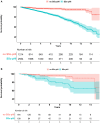Evaluation of Systemic Sclerosis Primary Heart Involvement and Chronic Heart Failure in the European Scleroderma Trials and Research Cohort
- PMID: 40008525
- PMCID: PMC12132611
- DOI: 10.1161/JAHA.124.036730
Evaluation of Systemic Sclerosis Primary Heart Involvement and Chronic Heart Failure in the European Scleroderma Trials and Research Cohort
Abstract
Background: Systemic sclerosis (SSc) primary heart involvement (SSc-pHI) is one of the leading causes of mortality in SSc. We aimed to evaluate risk factors for SSc-pHI and its progression and the outcomes in the EUSTAR (European Scleroderma Trials and Research) cohort.
Methods: SSc-pHI was defined according to the World Scleroderma Foundation/Heart Failure Association definition. Data from 5741 patients with SSc in the EUSTAR cohort were analyzed. Additional cardiovascular data were collected from a subcohort of 838 patients with SSc. Lasso regression was used for risk factor analyses. Kaplan-Meier estimator was used for survival analyses. Progression of SSc-pHI was evaluated by a study definition developed by rheumatology and cardiology experts.
Results: Risk factors for the presence of SSc-pHI comprised skeletal muscle atrophy (odds ratio [OR], 2.00 [95% CI, 1.00-2.68]), age (OR, 1.91 [95% CI, 1.73-2.03]), male sex (OR, 1.77 [95% CI, 1.42-2.05]), swollen joints (OR, 1.70 [95% CI, 1.47-1.98]), skeletal muscle weakness (OR, 1.38 [95% CI, 1.00-1.85]), and tendon friction rubs (OR, 1.46 [95% CI, 1.00-1.77]) (n=3276). Telangiectasia (OR, 2.10 [95% CI, 1.38-2.72]), intestinal symptoms (OR, 1.70 [95% CI, 1.04-2.42]), age (OR, 1.47 [95% CI, 1.21-1.62]), and antitopoisomerase I antibodies (OR, 1.37 [95% CI, 1.00-1.77]) were associated with an increased risk for new onset of SSc-pHI (n=1000). Survival rate was significantly lower in patients with SSc-pHI than in those without (P value <0.0001, n=3768). Patients with SSc-pHI had a lower survival rate than patients with interstitial lung disease (n=3365). Swollen joints were associated with an increased risk of progressive SSc-pHI (OR, 2.49 [95% CI, 1.79-3.52]) (n=595). Tendon friction rubs (OR, 1.21 [95% CI, 0.94-1.90]) increased the risk of heart failure with preserved ejection fraction in patients with SSc-pHI.
Conclusions: We defined progressive SSc-pHI and identified risk factors for new onset and progression of SSc-pHI and for SSc-pHI-associated heart failure with preserved ejection fraction in the largest cohort with SSc. These findings may guide patient stratification for diagnostic workup and therapy.
Keywords: EUSTAR cohort; mortality; risk factors; systemic sclerosis; systemic sclerosis primary heart involvement.
Conflict of interest statement
Dr Smith is senior clinical investigator of the Research Foundation—Flanders (Belgium) (FWO) [1.8.029.20N]. Dr Saketkoo is consultant or part of the advisory board for/of Argenx, aTyr, Boehringer Ingelheim, Kinevant, Mallinckrodt, Novartis, Scleroderma Foundation, Scleroderma Foundation of Chicago, Steffens Foundation. The remaining authors have no disclosures to report.
Figures





References
Publication types
MeSH terms
LinkOut - more resources
Full Text Sources
Medical

